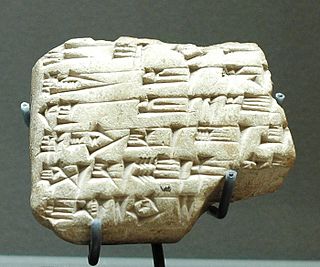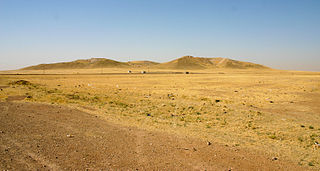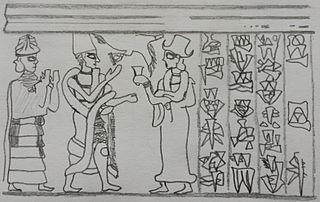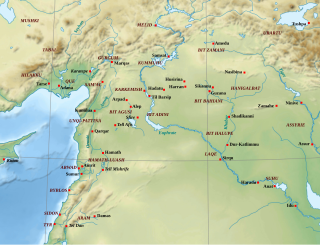
Babylonia was an ancient Akkadian-speaking state and cultural area based in central-southern Mesopotamia. A small Amorite-ruled state emerged in 1894 BC, which contained the minor administrative town of Babylon. It was a small provincial town during the Akkadian Empire but greatly expanded during the reign of Hammurabi in the first half of the 18th century BCE and became a major capital city. During the reign of Hammurabi and afterwards, Babylonia was called "the country of Akkad", a deliberate archaism in reference to the previous glory of the Akkadian Empire. It was often involved in rivalry with the older state of Assyria to the north and Elam to the east in Ancient Iran. Babylonia briefly became the major power in the region after Hammurabi created a short-lived empire, succeeding the earlier Akkadian Empire, Third Dynasty of Ur, and Old Assyrian Empire. The Babylonian Empire rapidly fell apart after the death of Hammurabi and reverted to a small kingdom.

Yamhad was an ancient Semitic kingdom centered on Ḥalab (Aleppo), Syria. The kingdom emerged at the end of the 19th century BC, and was ruled by the Yamhadite dynasty kings, who counted on both military and diplomacy to expand their realm. From the beginning of its establishment, the kingdom withstood the aggressions of its neighbors Mari, Qatna and Assyria, and was turned into the most powerful Syrian kingdom of its era through the actions of its king Yarim-Lim I. By the middle of the 18th century BC, most of Syria minus the south came under the authority of Yamhad, either as a direct possession or through vassalage, and for nearly a century and a half, Yamhad dominated northern, northwestern and eastern Syria, and had influence over small kingdoms in Mesopotamia at the borders of Elam. The kingdom was eventually destroyed by the Hittites, then annexed by Mitanni in the 16th century BC.

Mari was an ancient Semitic city-state in modern-day Syria. Its remains form a tell 11 kilometers north-west of Abu Kamal on the Euphrates River western bank, some 120 kilometers southeast of Deir ez-Zor. It flourished as a trade center and hegemonic state between 2900 BC and 1759 BC. The city was purposely built in the middle of the Euphrates trade routes between Sumer in the south and the Eblaite kingdom and the Levant in the west.

The Third Dynasty of Ur, also called the Neo-Sumerian Empire, refers to a 22nd to 21st century BC Sumerian ruling dynasty based in the city of Ur and a short-lived territorial-political state which some historians consider to have been a nascent empire.

Yahdunlim was the king of Mari probably in 1820—1796 BC. He was of Amorite origin, and became king after the death of his father Iagitlim. Yahdunlim built Mari up to become one of the major powers of the region. He led a successful campaign to the coast of the Mediterranean.

Tell Brak was an ancient city in Syria; its remains constitute a tell located in the Upper Khabur region, near the modern village of Tell Brak, 50 kilometers north-east of Al-Hasaka city, Al-Hasakah Governorate. The city's original name is unknown. During the second half of the third millennium BC, the city was known as Nagar and later on, Nawar.

Ekallatum (Akkadian: 𒌷𒂍𒃲𒈨𒌍, URUE2.GAL.MEŠ, Ekallātum, "the Palaces") was an ancient Amorite city-state and kingdom in upper Mesopotamia. The exact location of it has not yet been identified, but it is thought to be located somewhere along the left bank of the Tigris, south of Assur. A tablet fragment was found at Tel Hazor which listed an expected trade path from Hazor to Mari and then on to Ekallatum.
Ahlamu or Aḫlamū, were a group or designation of Semitic semi-nomads. Their habitat was west of the Euphrates, between the mouth of the Khabur and Palmyra.

Kurda was an ancient city-state and kingdom located in Northern Mesopotamia. Kurda emerged during the Early Dynastic Period (Mesopotamia) and is attested in the administrative texts of this era as a city state and geographical territory in Upper Mesopotamia corresponding to modern northern Iraq. The city-state of Kurda is again attested by the Akkadian king Naram Sin in 23rd century BCE in his military campaigns in the land of Subarians. Various Archives of Mari around 18th century BCE mention Kurda as an independent Kingdom, sometimes in alliance with Babylon and sometimes allied with Mari. Kurda is also mentioned in the Tell Fekheriye tablets of the Assyrian kings Šalmaneser I and Tukulti-Ninurta I, as one of the conquered territories in the Mitannian Empire.

The ancient Near East was the home of early civilizations within a region roughly corresponding to the modern Middle East: Mesopotamia, ancient Egypt, ancient Iran, Anatolia/Asia Minor and the Armenian highlands, the Levant, Cyprus and the Arabian Peninsula. The ancient Near East is studied in the fields of Ancient Near East studies, Near Eastern archaeology and ancient history.
Diniktum, inscribed Di-ni-ik-tumKI, was a middle bronze-age town located somewhere in the Diyala Governorate of Iraq. On the Tigris river downstream from Upi and close to the northern border of Elam. It is possibly at or in the vicinity of Tell Muḥammad, which lies in south-eastern part of modern Baghdad. Diniktum mentioned in the Harmal geographical list.
Gidara was an ancient city in northern Mesopotamia. It was located at the upper course of the Khabur river north of Guzana.
Yarim-Lim I, also given as Yarimlim, was the second king of the ancient Amorite kingdom of Yamhad in modern-day Aleppo, Syria.
Hassum was a Hurrian city-state, located in southern Turkey most probably on the Euphrates river north of Carchemish.

The Yamhad dynasty was an ancient Amorite royal family founded in c. 1810 BC by Sumu-Epuh of Yamhad who had his capital in the city of Aleppo. Started as a local dynasty, the family expanded its influence through the actions of its energetic ruler Yarim-Lim I who turned it into the most influential family in the Levant through both diplomatic and military tools. At its height the dynasty controlled most of northern Syria and the modern Turkish province of Hatay with a cadet branch ruling in the city of Alalakh.
Hanun-Dagan, was the Shakkanakku and king (Lugal) of Mari reigning c. 2016-2008 BC. He was the brother of his predecessor Hitlal-Erra, and is recorded as the son of Shakkanakku Puzur-Ishtar on a seal discovered in the city. Although the title of Shakkanakku designated a military governor, the title holders in Mari were independent monarchs, and nominally under the vassalage of the Ur III dynasty. Some Shakkanakkus used the royal title Lugal in their votive inscriptions, while using the title of Shakkanakku in their correspondence with the Ur's court, and it is certain that Hanun-Dagan used the royal title.

Bit-Ḫalupe, an ancient Aramean state in eastern Syria, located within the triangular area formed by the confluence of the Khabur River with the Euphrates River. It was one of the four Aramean states that bordered Assyria. The others were Bit-Zamani, Bit Bahiani and Laqe. By the ninth century BC all of them were assimilated by Assyria.

The Shimashki or Simashki dynasty, was an early dynasty of the ancient region of Elam, to the southeast of Babylonia, in approximately 2100-1900 BCE. A list of twelve kings of Shimashki is found in the Elamite king-list of Susa, which also contains a list of kings of Awan dynasty. It is uncertain how historically accurate the list is, although some of its kings can be corroborated by their appearance in the records of neighboring peoples. The Dynasty corresponds to the middle part of the Old Elamite period. It was followed by the Sukkalmah Dynasty. Shimashki was likely near today's Masjed Soleyman.

The Sukkalmah Dynasty, also Epartid Dynasty after the founder Eparti/Ebarat, was an early dynasty of West Asia in the ancient region of Elam, to the southeast of Babylonia. It corresponds to the latest part of the Old Elamite period.
Andarig or Anderiq was a middle bronze age kingdom in the Sinjar Plain region of northern Mesopotamia, located between the Habur and Tigris river. It is mentioned several times in the documents found in Mari. Andarig was one of the largest and most powerful kingdoms in the region. It was the most important holding of the Amorite Yamutbal tribe.












